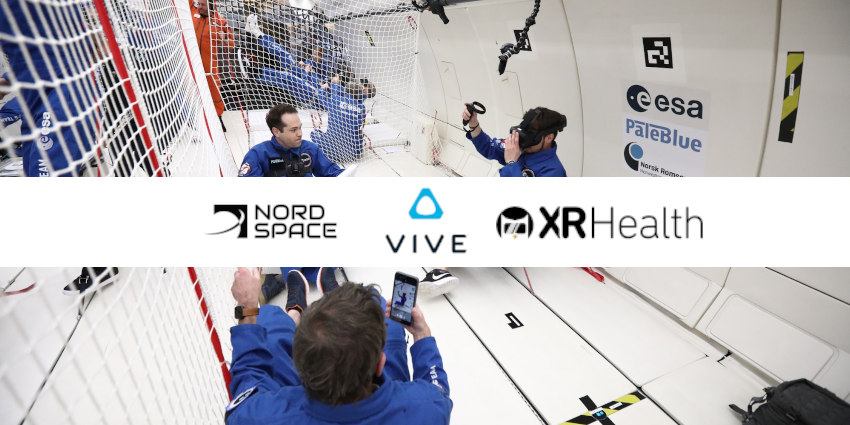XRHealth and HTC VIVE are set to blast off with a groundbreaking solution in a major partnership to help astronauts tackle mental health issues.
In a 5 November lauch date to the International Space Station (ISS), XRHealth’s immersive healthcare solution will set course for the stars with HTC VIVE and Nord-Space Aps.
HTC VIVE will configure specifications of some of its VIVE Focus 3 headsets to the conditions of microgravity in space, allowing astronauts to use the device for their mental health during missions.
Some of the mental health environmental triggers for astronauts on long space missions include living in isolation or non-stimulating, highly stressful environments.

Using Nord Space’s virtual reality mental health (VRMH) tools, astronauts can treat their specific needs while orbiting for their space missions. Doing so can lead to greater mental health and potentially, greater efficiency in space missions and assignments.
Nord Space has remained a major enterprise focused on mental health research for space exploration and aims to show the positive effects of VRMH, before and after its use.
For example Danish Astronaut Andreas Mogensen will become the world’s first-ever cosmonaut to leverage VR headsets during his six to eight month mission with NASA Crew-7.
He will incorporate health and wellness programmes from the HTC VIVE and Nord Space collaboration for his lengthy mission. With HTC VIVE’s modified Focus 3 headset, he will participate in simulations developed and adapted for working in microgravity environments.
Problems with VR and Microgravity
Previously, VR headsets operating in microgravity or near-zero gravity created major hurdles for functionality. Several issues included jittering, drifting, rolling, and other alignment issues with physical environments led to motion sickness or problems experiencing immersive content while using the headset.
Due to a lack of gravity vectors, using headsets in microgravity leads to drifting and misalignment, rendering VR headsets unusable. This would take place in a matter of minutes after use for previous experiments.
However, with Nord Space, XRHealth, and HTC VIVE collaborating by engineering the novel space-focused VR platform, astronauts can now resolve these discrepancies with tracking misalignment.
For those using the new solution, they can operate their headsets in space via a simulator mode along with special tracking methodologies incorporated into the controllers.
Comments on HTC VIVE-XRHealth Space Exploration Partnership
Per Lundahl Thomsen, Chief Technology Officer, Nord-Space Aps, said: “Astronauts are essentially isolated during their missions for months and years at a time and are confined to small spaces with limited contact with friends and family.”
He continued,
“Creating a virtual platform that addresses their mental health needs while in isolation is imperative for them to maintain a healthy lifestyle when they return. We partnered with companies that provide the most advanced technologies that could be adapted for space to provide the most beneficial experience for our astronauts”
Additionally, Cher Wang, Chairwoman and Co-Founder, HTC, hailed the collaboration and use of HTC VIVE’s technology as an “honor.”
This was especially that the devices could “tackle some of humanity’s most complex challenges in space exploration: isolation and mental health,” she added.
Wang continued,
“It’s a testament to our culture of innovation that VIVE Focus 3 was selected out of multiple VR headsets to accompany NASA Crew-7 on their months-long mission to the ISS. Our team tackled unique challenges to configure the headset for use in microgravity conditions, and ultimately pushed the boundaries of what’s possible in VR. Astronauts will be able to get the same mental health benefits of immersive tech as we do on earth. It’s a groundbreaking moment”
Additionally, Eran Orr, Chief Executive, XRHealth, added that his company was “harnessing nspatial computing technologies” to improve health for many people worldwide “and now even in space.”
He concluded,
“We are excited and proud to deploy the first headset on a space mission to relieve the pressure and stress so astronauts will be able to keep top performance while doing crucial space missions.”
Previous HTC VIVE-XRHealth Collaborations
The annoncement comes after XRHealth and HTC VIVE worked jointly on a venture to integrate the latter’s HTC VIVE Flow and Focus 3 headsets.
Revealed in March last year, the two companies have remained collaborative since unveiliing the news at the HIMSS Global Health Conference and Exhibition in Orlando, Florida at the time. With the partnership, both HTC VIVE and XRHealth aimed to democratise telehealth and healthcare solutions for hospitals, rehabilitation centres, and patients.
For those using the solution, healthcare professionals and patients can join telemedicine calls and outline treatment plans using remote consultations with health clinicians.
XRHealth has also received US Food and Drug Administration (FDA) approval and is CE registered. This allows the firm to treat mental health, autism, multiple sclerosis, autism, ADHD, and Parkinson’s, amongn others. Patients and doctors can also retroactively track programme outcomes and patient progress with the immersive tools.
An Apple (Vision Pro) a Day Keeps the Doctor Away?
Treatments like these have been used across the XR space. With the upcoming release of the Apple Vision Pro, reports show that Apple could leverage the next-gen device for treating mental health issues like depression, stress, anxiety, post-traumatic stress disorder (PTSD), and many other concerns.
Some advancements in eye tracking, gait detection, face tracking, and others could allow the Apple Vision Pro to accurately detect a persons expression of emotions.
Referring to the “affect” used in psychology, The Information’s Wayne Ma reported that patients can exhibit “flat affects,” or emotionless facial expressions, indicating mental health issues.
For the novel headset, the Apple Vision Pro can also tap its infrared eye tracking cameras to locate swelling in blood vessels. This can determine whether a patient is suffering from early sighs of heart failure.
Furthermore, the Vision Pro could also treat phobias and triggers linked to anxieties. This technique has been routinely incorporated into solutions from Psious VR, used by the British National Health Services (NHS).
Swedish digital healthcare firm Kry has also launched its platform to help people tackle their phobias. Additionally, Warpin Reality, a Swedish XR training firm, teamed up with the Swedish Red Cross to train individuals to improve their reaction times, overcome fears, and treat others experiencing medical crises.
Regarding the Apple Vision Pro, more testing and certification will become crucial to the device’s success as a heathcare solution. The Information’s report, citing sources close to the matter, also indicated that people inside the Cupertino-based firm had mulled or explored use cases in healthcare for the future device.
Wayne Ma, the author of The Information report, also stated that Apple had explored mental health detection capabilities for the iPhone’s front-facing cameras to detect mood, app usage, or typing habits to detect Alzheimer’s.







